SHARE
Our Picks: Top 10 Business Books of 2014
Our recommended Business Books
Every once in a while we share what we have been reading and enjoying in the areas such as innovation, operations, entrepreneurship or business in general. As we are getting closer to the end of the year we thought maybe it's time to create our own Top 10 business books list: What comes below is a compiled list of some of the most exciting and inspiring titles we came across this year. If you haven't read these books, we strongly encourage you to do so. And we have a bonus for you too: Below you can also find a video from Bill Gates where he shares his favorite books in 2014. Image courtesy of amazon
Image courtesy of amazonCreativity, Inc. For nearly twenty years, Pixar has dominated the world of animation, producing such beloved films as the Toy Story trilogy, Monsters, Inc., Finding Nemo, The Incredibles, Up, and WALL-E, which have gone on to set box-office records and garner thirty Academy Awards. The joyousness of the storytelling, the inventive plots, the emotional authenticity: In some ways, Pixar movies are an object lesson in what creativity really is. Here, in this book, Catmull reveals the ideals and techniques that have made Pixar so widely admired—and so profitable.
 Image courtesy of amazon
Image courtesy of amazonHooked: How to Build Habit-Forming Products Why do some products capture widespread attention while others flop? What makes us engage with certain products out of sheer habit? Is there a pattern underlying how technologies hook us? Nir Eyal answers these questions (and many more) by explaining the Hook Model—a four-step process embedded into the products of many successful companies to subtly encourage customer behavior. Through consecutive “hook cycles,” these products reach their ultimate goal of bringing users back again and again without depending on costly advertising or aggressive messaging. Hooked is based on Eyal’s years of research, consulting, and practical experience. He wrote the book he wished had been available to him as a start-up founder—not abstract theory, but a how-to guide for building better products. Hooked is written for product managers, designers, marketers, start-up founders, and anyone who seeks to understand how products influence our behavior.
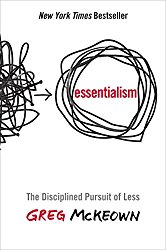 Image courtesy of amazon
Image courtesy of amazonEssentialism: The Disciplined Pursuit of Less The Way of the Essentialist isn’t about getting more done in less time. It’s about getting only the right things done. It is not a time management strategy, or a productivity technique. It is a systematic discipline for discerning what is absolutely essential, then eliminating everything that is not, so we can make the highest possible contribution towards the things that really matter. By forcing us to apply a more selective criteria for what is Essential, the disciplined pursuit of less empowers us to reclaim control of our own choices about where to spend our precious time and energy – instead of giving others the implicit permission to choose for us. Essentialism is not one more thing – it’s a whole new way of doing everything. A must-read for any leader, manager, or individual who wants to learn who to do less, but better, in every area of their lives, Essentialism is a movement whose time has come.
What does Bill Gates Read?
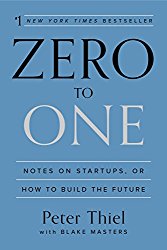 Image courtesy of amazon
Image courtesy of amazonZero to One: Notes on Startups, or How to Build the Future The great secret of our time is that there are still uncharted frontiers to explore and new inventions to create. In Zero to One, legendary entrepreneur and investor Peter Thiel shows how we can find singular ways to create those new things. Thiel begins with the contrarian premise that we live in an age of technological stagnation, even if we’re too distracted by shiny mobile devices to notice. Information technology has improved rapidly, but there is no reason why progress should be limited to computers or Silicon Valley. Progress can be achieved in any industry or area of business. It comes from the most important skill that every leader must master: learning to think for yourself. Doing what someone else already knows how to do takes the world from 1 to n, adding more of something familiar. But when you do something new, you go from 0 to 1. The next Bill Gates will not build an operating system. The next Larry Page or Sergey Brin won’t make a search engine. Tomorrow’s champions will not win by competing ruthlessly in today’s marketplace. They will escape competition altogether, because their businesses will be unique.
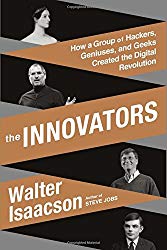 Image courtesy of amazon
Image courtesy of amazonThe Innovators: How a Group of Hackers, Geniuses, and Geeks Created the Digital Revolution Following his blockbuster biography of Steve Jobs, The Innovators is Walter Isaacson’s revealing story of the people who created the computer and the Internet. It is destined to be the standard history of the digital revolution and an indispensable guide to how innovation really happens. What were the talents that allowed certain inventors and entrepreneurs to turn their visionary ideas into disruptive realities? What led to their creative leaps? Why did some succeed and others fail? In his masterly saga, Isaacson begins with Ada Lovelace, Lord Byron’s daughter, who pioneered computer programming in the 1840s. He explores the fascinating personalities that created our current digital revolution, such as Vannevar Bush, Alan Turing, John von Neumann, J.C.R. Licklider, Doug Engelbart, Robert Noyce, Bill Gates, Steve Wozniak, Steve Jobs, Tim Berners-Lee, and Larry Page. This is the story of how their minds worked and what made them so inventive. It’s also a narrative of how their ability to collaborate and master the art of teamwork made them even more creative.
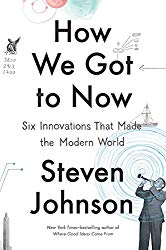 Image courtesy of amazon
Image courtesy of amazonHow We Got to Now: Six Innovations That Made the Modern World In this illustrated history, Steven Johnson explores the history of innovation over centuries, tracing facets of modern life (refrigeration, clocks, and eyeglass lenses, to name a few) from their creation by hobbyists, amateurs, and entrepreneurs to their unintended historical consequences. Filled with surprising stories of accidental genius and brilliant mistakes—from the French publisher who invented the phonograph before Edison but forgot to include playback, to the Hollywood movie star who helped invent the technology behind Wi-Fi and Bluetooth—How We Got to Now investigates the secret history behind the everyday objects of contemporary life. In his trademark style, Johnson examines unexpected connections between seemingly unrelated fields: how the invention of air-conditioning enabled the largest migration of human beings in the history of the species—to cities such as Dubai or Phoenix, which would otherwise be virtually uninhabitable; how pendulum clocks helped trigger the industrial revolution; and how clean water made it possible to manufacture computer chips. Accompanied by a major six-part television series on PBS, How We Got to Now is the story of collaborative networks building the modern world, written in the provocative, informative, and engaging style that has earned Johnson fans around the globe.
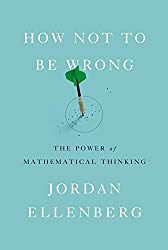 Image courtesy of amazon
Image courtesy of amazonHow Not to Be Wrong: The Power of Mathematical Thinking The math we learn in school can seem like a dull set of rules, laid down by the ancients and not to be questioned. In How Not to Be Wrong, Jordan Ellenberg shows us how terribly limiting this view is: Math isn’t confined to abstract incidents that never occur in real life, but rather touches everything we do—the whole world is shot through with it. Math allows us to see the hidden structures underneath the messy and chaotic surface of our world. It’s a science of not being wrong, hammered out by centuries of hard work and argument. Armed with the tools of mathematics, we can see through to the true meaning of information we take for granted: How early should you get to the airport? What does “public opinion” really represent? Why do tall parents have shorter children? Who really won Florida in 2000? And how likely are you, really, to develop cancer? How Not to Be Wrong presents the surprising revelations behind all of these questions and many more, using the mathematician’s method of analyzing life and exposing the hard-won insights of the academic community to the layman—minus the jargon. Ellenberg chases mathematical threads through a vast range of time and space, from the everyday to the cosmic, encountering, among other things, baseball, Reaganomics, daring lottery schemes, Voltaire, the replicability crisis in psychology, Italian Renaissance painting, artificial languages, the development of non-Euclidean geometry, the coming obesity apocalypse, Antonin Scalia’s views on crime and punishment, the psychology of slime molds, what Facebook can and can’t figure out about you, and the existence of God.
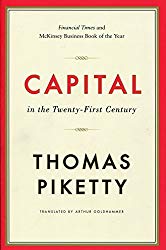 Image courtesy of Amazon
Image courtesy of AmazonCapital in the Twenty-First Century Thomas Piketty's "Capital in the Twenty-First Century" is a brilliant analysis of the long term distribution of income and wealth. The book draws on reams of data from the United States and numerous other countries. Most of the data come from income tax records and estate tax/inheritance records. The sheer quantity of data that underlies Piketty's conclusions is unprecedented, and as a result, his work deserves a great deal of credibility. Piketty not only provides important data, and the historical context and analysis, but makes some very clear policy prescriptions. Tax inheritances, get some sane corporate governance standards to stop the insane overpaying of executives and strengthen public institutions that provide an opportunity to the masses.
 Image courtesy of amazon
Image courtesy of amazonThe Road to Reinvention Companies, communities, and individuals fall for many reasons, but one of the most common—and easily avoidable—is the failure to reinvent. When people and organizations rest on prior successes rather than driving purposeful transformation, they discover too late that they have lost their market position altogether to competitors and external forces. The most successful companies, brands, and individuals make reinvention a regular part of their business strategies. Transformation demands an ongoing process of discovery and imagination, and The Road to Reinvention lays out a systematic approach for continually challenging and reinventing yourself and your business. Venture capitalist and serial entrepreneur Josh Linkner identifies six elements in any business that is ripe for reinvention and shares examples, methods, and step-by-step techniques for creating deliberate, productive disruption. Throughout The Road to Reinvention, Linkner also explores the history—the great rise, unprecedented fall, and now rebirth—of his beloved hometown, Detroit. First rising to greatness as the result of breathtaking innovation, Detroit had generations of booming growth before succumbing to apathy, atrophy, and finally bankruptcy. Now, the city is rising from the ashes and driving sustainable success through an intense focus on reinvention. Linkner brings an insider's view of this incredible story of grit, determination, and creativity, sharing his perspective on Detroit's successes and setbacks as a profound example of large-scale organizational and personal transformation.
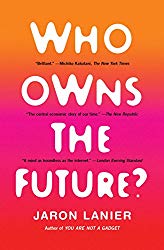 Image courtesy of Amazon
Image courtesy of AmazonWho Owns the Future? Jaron Lanier is the father of virtual reality and one of the world’s most brilliant thinkers. Who Owns the Future? is his visionary reckoning with the most urgent economic and social trend of our age: the poisonous concentration of money and power in our digital networks. Lanier has predicted how technology will transform our humanity for decades, and his insight has never been more urgently needed. He shows how Siren Servers, which exploit big data and the free sharing of information, led our economy into recession, imperiled personal privacy, and hollowed out the middle class. The networks that define our world—including social media, financial institutions, and intelligence agencies—now threaten to destroy it. But there is an alternative. In this provocative, poetic, and deeply humane book, Lanier charts a path toward a brighter future: an information economy that rewards ordinary people for what they do and share on the web. Featured Photo credit: hollybroadland / IWoman / CC BY-NC-ND Download our Engineering Crowdsourcing white paper
